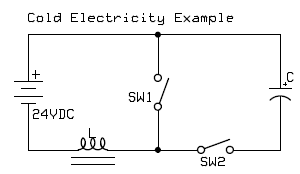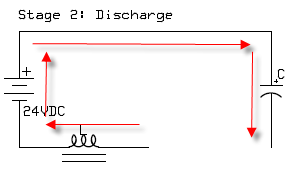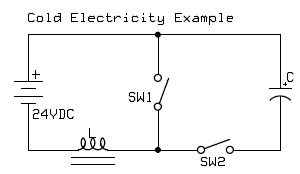Cold electricity is generated using an unconventional principle via the negative line of an LC network, which stimulates the flow of positive charge in the line, causing an entropic negative charge to develop across the inductor, which is eventually transferred into the capacitor as "cold" electricity.
It's termed as "cold" since it works within a open circuit, without dissipating any form of heat in the process.
In this post I have explained how to generate cold electricity using a simple circuit wherein a capacitor is charged with high voltage without consuming any power from the connected battery supply.
Using a Single Inductor
There used to be an Youtube video illustrating the interesting phenomenon of the generation of cold electricity using just an inductor, a few switches and a supply voltage source.
Initially it appeared nothing but simply a buck-boost kind of configuration, however a closer look indicated something very unusual with the happenings within the circuit.
Analyzing the Cold Electricity Phenomenon
Let's analyze and try to grasp the situation which points towards the generation of the intriguing cold electricity. In the shown figure below, we see a very basic circuit consisting of a couple of SPDT switches, a high voltage capacitor, an inductor and a 24V DC supply.
Here as soon as both the switches are closed and opened quickly together, the capacitor could be seen getting charged to a voltage equivalent to the inductance back emf value.

- L = 800 turns bifilar coil around a ferrite core, about 30 ohms
- C= 30μF, 4000VDC
In the above circuit, both the switches needs to be closed and opened briskly together.

At the instant when the switches are closed, as per the standard rules the inductor would store the energy in the form of magnetic energy, this would result a high resistance across the battery, allowing no current to be consumed by the inductor.

But as soon as the switches are opened, the capacitor could be seen getting charged up with a high voltage from the inductor.
Inductor Internal Energy Saturation
The question that arises is how the potential difference could reach across the capacitor with the switches being open and the circuit making no closed loop for the capacitor to charge up?
According to the author, in this example, the effect occurs due to the electrical energy which comes in contact with the resistance (open switch) wherein the current inside the inductance saturates the resistance.
Another source explains it in the following manner:
Creating Singularity Situation
With the switches closing and opening quickly, a singularity situation is created within the circuit due to the fact that the change in the current cannot be interrupted across the inductor.
Before the magnetic field across the inductor is able to die down, it experiences a voltage magnification across the coil.
This magnified voltage charges the capacitor without consuming any current from the battery.
The Ferroresonance Effect
This could be explained as the ferroresonance effect wherein as the core of the inductor is saturated, the potential moves in through an unconventional negative path, influencing the positive charge and prompting a negative entropic field to be induced inside the inductor which finally becomes responsible for charging up the capacitor.
